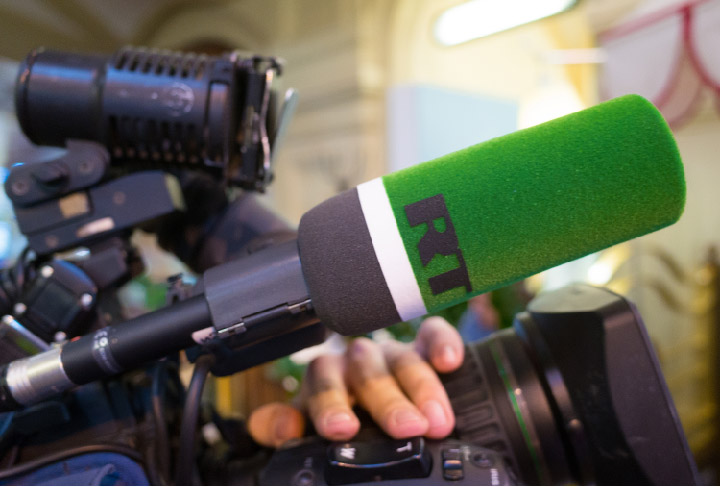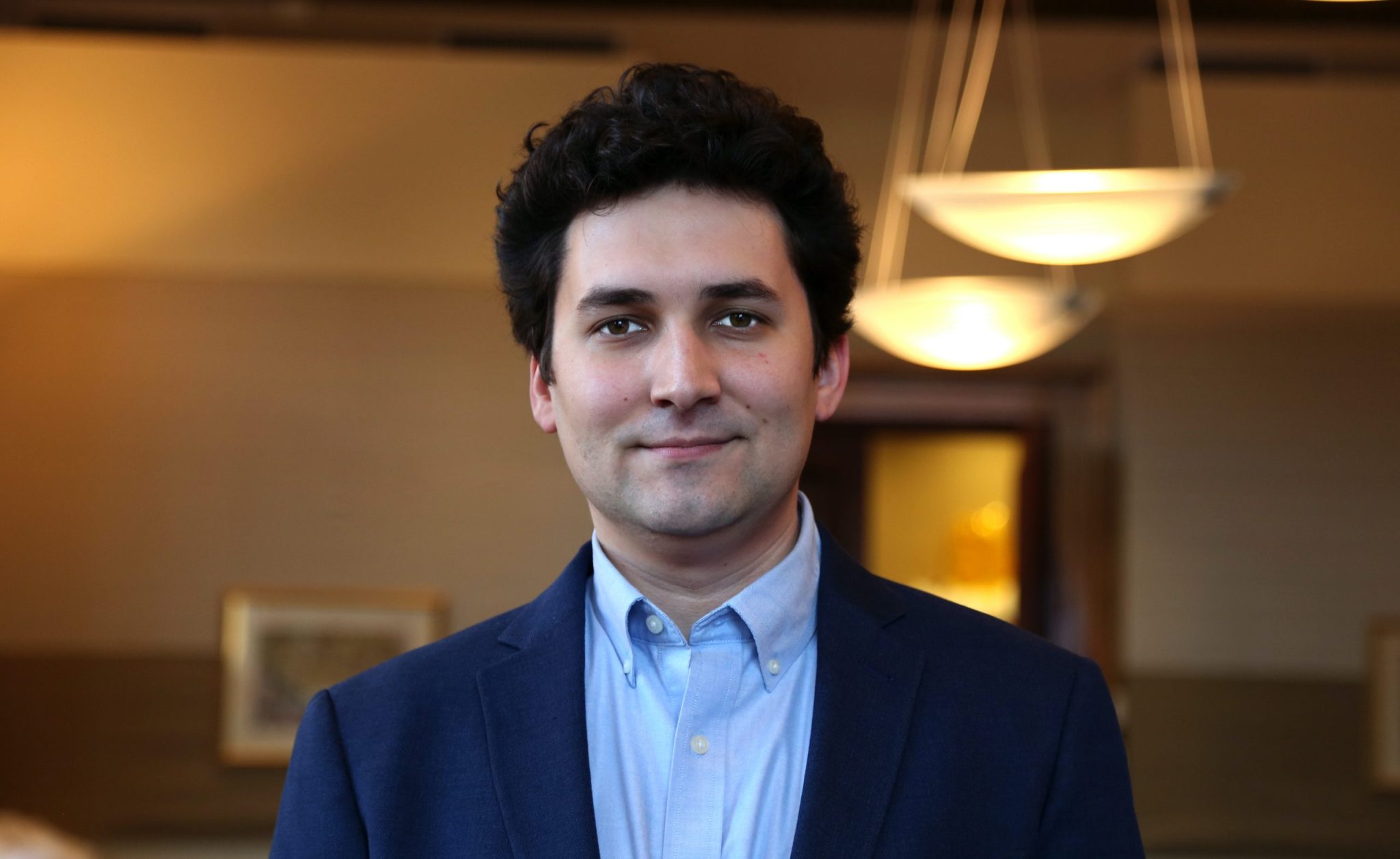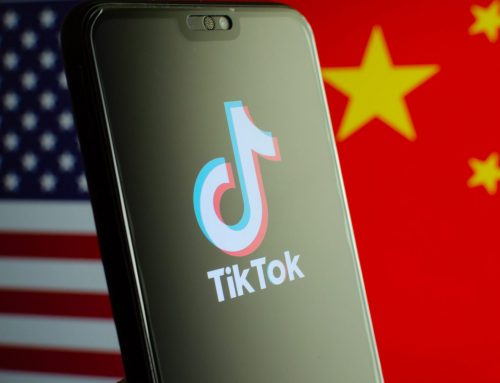Overview
As with the past four months, the coronavirus was yet again the primary topic discussed by Russian, Chinese, and Iranian messengers, though the specific narratives differed depending on the country. China’s diplomats and state media, for example, attacked a Harvard report suggesting that the coronavirus first appeared in Wuhan as early as August 2019, Russian messengers touted advances from Russian scientists in the development of a coronavirus vaccine, and Iranian state media promoted its humanitarian aid to Venezuela in defiance of U.S. sanction. In addition to coronavirus coverage, protests in the United States and other democratic countries were again a focus, though the volume of coverage dropped significantly (note: this report covers a date range before the shooting of Rayshard Brooks and subsequent protests in Atlanta). Across the three dashboards, uses of the hashtag #GeorgeFloyd declined by nearly 63 percent (though it remained the seventh most used hashtag overall), with #BlackLivesMatter and #GeorgeFloydProtests dropping out the top ten most used hashtags. At the same time, all three countries continued to use anti-racism protests in democratic countries as an opportunity to push their messaging hobby-horses, from historical revisionism narratives in the case of Russia to criticism of U.S. sanctions and “interference” in the cases of Iran and China.
Russia Toplines
Both the coronavirus and the global anti-racism protests touched off by the killing of George Floyd were prominent topics for the Russian media ecosystem last week. Amid broader protest coverage, Russian media weighed in on various sides of the debate over the removal of monuments to historical figures involved in slavery, colonialism, and similar activities with lasting impacts on systemic discrimination. They largely highlighted the spectacle of statue removal and related claims about whether or not doing so constitutes historical revisionism. Russian diplomats on Twitter also marked Russian Language Day and Russia Day with a spate of messaging, some of which emphasized Russia’s multiculturalism and unity.
China Toplines
With Beijing’s interest in the protests in the United States fading, last week marked a return of coronavirus-related stories at the top of Hamilton’s charts. In particular, a Harvard study using satellite imagery to suggest that the virus had appeared in Wuhan as early as August 2019 provoked a strong reaction from the Chinese government and media accounts monitored on the dashboard. In addition, a string of stories last week on Australia, Taiwan, and Xi Jinping’s visit to Ningxia province suggests that Beijing may be refocusing its attention on issues closer to home.
Iran Toplines
Iranian state-controlled media divided its focus this week between covering turmoil in the United States (both the coronavirus pandemic and ongoing protests against racism and police violence) and attacking American foreign policy for disregarding international laws and norms. These threads were occasionally woven together, as when President Hassan Rouhani declared that the United States has had its knee on the neck of Iran for years—a thinly veiled reference to the killing of George Floyd. A third minor thread in the narratives trumpeted achievements in furthering Iranian cooperation with Venezuela, casting the two countries as a bulwark against American pressure.
Russia
Russian State Media Wade into the Debate about Racist Statues and Historical Revisionism
Continuing anti-racism and police brutality protests again constituted an important topic for the Russian state media ecosystem last week. Coverage continued to emphasize iconic viral images of the protests, and it also kept up with messaging about systemic racism in the United States. For example:




Among many other impacts, the protests have facilitated increased visibility of debates on removing public monuments to Confederate and colonial leaders in the United States and those to slave traders and colonial figures internationally, particularly in Europe. Russian state-backed media have weighed in on both sides of this renewed controversy, perhaps taking advantage of the heavy symbolism associated with statues and claims of historical revisionism from both sides of the debate—a sensitive topic given Russia’s frequent protestations over the removal of Soviet war memorials in Central and Eastern Europe.
A frequent theme in last week’s coverage of the statue debates focused on the spectacle of statues being toppled or defaced by groups of demonstrators and the sheer number of potential targets for take-down. Content also featured some argumentation about the need for people to learn more about “real” history.





“Churchill next? Tearing down of British slave trader statue prompts wave of suggestions for further destruction,” RT, June 8, 2020.
“After protesters in the city of Bristol dramatically tore down a statue of 17th-century slave trader Edward Colston on Sunday, a wave of suggestions for whose effigy should be destroyed next has been unleashed . . . The striking scenes have prompted a raft of suggestions for further demolitions, as some in Britain have suggested that the country should attempt to come to terms with its blood-drenched history.”
“Destroy EVERYTHING! Will culture police keen to purge historical racism turn to museums, galleries and libraries next?” Op-ed, RT, June 10, 2020.
“Councils across the UK should rethink their plans to review statues that are deemed offensive. Trying to curate the past to fit in with the present will only lead to more destruction, and ultimately division. Trouble is brewing on the statue front, with various sides preparing to either defend or attack historical bronzes around the UK this weekend. So you’d think our political leaders would do something to defuse the tension and adopt a more considered approach to dealing with the issue of historical racism.”
“Where Does It All End? Anti-Racist Group Draws Up Hitlist of Statues They Want to Tear Down,” Sputnik News, June 11, 2020.
“Black Lives Matter activists tore down a statue of slave trader Edward Colston at the weekend and threw it into Bristol’s harbour. It comes in the wake of a global questioning of “racist” statues following the death of George Floyd at the hand of white police officers last month. Edward Colston’s statue has been fished out of the water in Bristol and is set to be rehoused in a museum but the demand for the removal of other figures from British history grows unabated.”
“We’re fighting over statues because we don’t learn enough history, warts and all,” Op-ed, RT, June 11, 2020.
“History isn’t ‘being erased’ by the removal of statues. It’s been erased over centuries by those in power. The only way to judge the past properly is by teaching ALL history – good, bad and downright ugly.”
“Tearing Down Symbols of Slavery and Racism Should be Applauded,” Column, Sputnik News, June 9, 2020.
“. . . An offensive symbol of brutal and inhumane slavery was torn from its plinth in an act of cultural enlightenment which was long overdue. The Black Lives Matter demonstration in the city made a statement which will go down in history as a progressive blow against the continued honouring of the dishonourable and the concealment of real British history which reeks from head to toe with the stench of brutal slaughter, bloody oppression and greedy plunder and theft.”
“Historical perspective: how do we chose what statues to remove?” RT UK, June 10, 2020.
“”I get it is offensive for black people to see these statues on display – but also people in Africa made money out of white slaves – so it’s not just a white thing.” Barrister Rebecca Butler understands desires to remove statues but asks for balance with the removal of them.”
Finally, it is worth noting that the debate about World War II-era UK Prime Minister Winston Churchill attracted particular interest from Russian state media. There seemed to be a greater push to defend Churchill than other historical figures who have attracted renewed controversy in recent weeks, specifically due to his role in the Allied victory in World War II; although, some Twitter accounts (namely those associated with RT’s left-leaning programs) highlighted particularly racist Churchill quotes:



“Winston Churchill Statue Defaced on D-Day Anniversary Amid George Floyd Protests in London,” Sputnik News, June 6, 2020.
“. . . A statue of the iconic British Prime Minister Winston Churchill was vandalized on Saturday, on the 76th anniversary of D-Day. The day marks beach landings in Normandy by Allied forces, led in part by the British army commander, as hundreds of thousands of soldiers en masse invaded northern France during the Second World War.”
“#BLM protesters should be taking a knee at Churchill statue, not defacing it. Here’s why,” Op-ed, RT, June 9, 2020.
“The UK Black Lives Matter protesters who sprayed graffiti over the Churchill monument in London are conveniently forgetting there mightn’t be any ethnic minorities still living in the UK today, if Nazi Germany had won WWII.”
“‘Woke warriors seem to be winning’: Brexit Party chairman calls for protective covering around Churchill statue to be removed,” RT, June 12, 2020.
“Brexit Party Chairman Richard Tice has called for the protective hoarding around the Winston Churchill monument in London to be removed, despite fears of violence and potential vandalism at this weekend’s protests. Addressing UK Prime Minister Boris Johnson and London Mayor Sadiq Khan directly, Tice said ‘the woke warriors seem now to be winning over the United Kingdom,’ adding that ‘the greatest Briton’ had now ‘disappeared.’”
“Statues attacked — is Winston Churchill’s next?” RT America, June 9, 2020.
“Black Lives Matter protesters have begun to target statues across the UK, including that of Winston Churchill.” Note that the segment begins with the anchor asking, “Is there real talk of an assault on the legacy and the memory of Winston Churchill there in London?”
While the controversy over Churchill also featured in other media, it is noteworthy in the Russian context due to the country’s relationship with its own problematic World War II leader, Josef Stalin. Indeed, the increasing association of Stalin with the wartime victory rather than his leading role in the deaths of millions during the 1930s Great Terror in Russian historical narratives has resulted in a steady rise in Russian public approval of the leader and the construction of new monuments to him in recent years.
Russian Commemorative Days and Public Diplomacy
Last week featured coverage of two Russian holidays: Russian Language Day, coinciding with Russian poet and “founder of modern Russian literature” Alexander Pushkin’s birthdate (June 6), and Russia Day (June 12). Indeed, half of the top ten hashtags from tracked accounts on Twitter referenced Russia Day, though many of the individual tweets used all of these hashtags, meaning the relative dominance of this topic in hashtags likely did not reflect a similar pattern overall. Only a very small amount of related content, all from TASS, appeared outside of Twitter. Messaging marking these dates featured standard public diplomacy content, such as celebratory coverage of Russian literature, highlights of Russian culture, and images of landscapes and tourist attractions. A very small subset of this content emphasized Russia’s multiculturalism and large number of nationalities, while making claims about the country’s unity, such as through the Russian language:


“Putin confident most Russians will support amendments on protecting history and borders,” TASS, June 12, 2020.
“Russian President Vladimir Putin voiced confidence that the constitutional amendments aimed at protecting historic truth and inviolability of Russian borders will be backed by the overwhelming majority of citizens . . . ’Here, on Poklonnaya Hill, we remember the heroes who defended the Motherland, its freedom and independence and this memory is common and sacred for all generations for the entire multi-ethnic people of Russia,’ Putin stressed.”
This type of content is quite typical in Russia’s official narratives about the country and its history. However, given the attention that Russian diplomats and state-funded media have given to the George Floyd protests and systemic racism in the West, it is perhaps surprising that they did not lean on this narrative more forcefully. In this context, Russian Language Day/Pushkin’s birthday might have seemed like an opportunity to highlight the story of Pushkin’s great-grandfather, Abram Petrovich Gannibal, who, after being kidnapped as a child from an uncertain location in Africa, was eventually adopted as a godson by Peter the Great. On the other hand, while various countries have been moved to take a deeper look at addressing their own historical legacies of injustice, Russia has consistently displayed a pattern of historical revisionism that glosses over controversial and problematic aspects of its history, including the lasting impacts of Soviet language and nationalities policies. The country also continues to wield claims of linguistic discrimination against Russian speakers abroad as a geopolitical tool:

Russian state-funded media and government and diplomatic corps accounts:
Top 10 Hashtags — June 6-12:
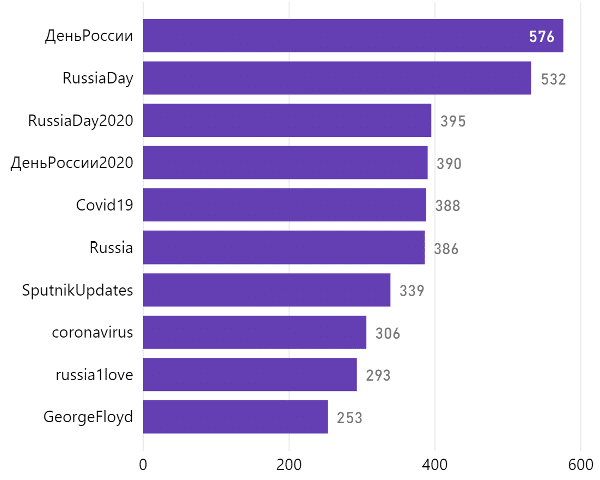
From June 6 to June 12, the dashboard collected about 18,000 tweets from tracked accounts, which is slightly up from the previous week. About 10 percent of collected tweets mentioned “virus,” “covid,” “outbreak,” or any combination of those terms, which was about the same proportion as the previous week. Meanwhile, about 7 percent referenced George Floyd specifically or used the word protest (or both), which was about half as much as the previous week. As normal, coronavirus coverage focused primarily on basic news, including reports of progress made on a potential treatment in Russia.
Websites
Russian government-funded websites:
Last week, about 22 percent of output from Russian state-funded news websites mentioned “protest” in the first 200 words, while another 22 percent mentioned “virus.” Both figures show a marginal decline from the previous week. The top article on the protests based on Facebook shares was a reprint of an op-ed by a U.S. law enforcement officer who has decided to resign due to public animosity toward police, while the top coronavirus-related article covered Belarusian President Alexander Lukashenko’s accusation that global elites have used the pandemic to enrich themselves:
“‘You won’t need to abolish us – we won’t be around for it’: Why many police officers like me are quitting the force,” Op-ed, RT, June 10, 2020.
“The nasty words we, the police, get called all the time have now turned into rocks, bottles and gunfire. It’s over, America: we are leaving.”
“Belarus’s Lukashenko Slams Global Elites, Says They’ve Made ‘Trillions’ as Economy Burns to Pandemic,” Sputnik News, June 7, 2020.
“One of the only countries in Europe not to institute strict lockdown measures amid the coronavirus crisis, Belarus has so far managed to keep virus-related fatalities impressively low. Belarusian President Alexander Lukashenko has taken a shot at the world’s elites, accusing them of taking advantage of the coronavirus pandemic to put ‘trillions of dollars in their pockets’ while the global economy burns.”
Broadcasts
Notable among videos on topics not covered above, RT America, which features sparse coverage of Russia, elevated a reported breakthrough on a coronavirus treatment in Russia:
“Breaking: Russian scientists unveil breakthrough COVID-19 drug,” RT America, June 8, 2020.
“Russian researchers have developed a medicine which they say can alleviate the worst symptoms of COVID-19 infection without side effects. Levilimab, originally intended to treat rheumatoid arthritis, has received official approval and is expected to appear in hospitals as early as July.”
“Russian COVID-19 drug passes new hurdle,” RT America, June 9, 2020.
“Russian researchers are optimistic about a breakthrough medicine called Levilimab, which they say can alleviate the worst symptoms of COVID-19 infection. Meanwhile, the race toward a novel coronavirus vaccine continues in countries around the world.”
As usual, an update on Jeffrey Epstein also made the cut for RT America:
“What is Prince Andrew hiding from prosecutors,” RT America, June 9, 2020.
“The UK’s Prince Andrew is reportedly unwilling to cooperate with the investigation into the crimes of infamous pedophile Jeffrey Epstein, according to US prosecutors. Prince Andrew’s attorneys deny the allegation.”
Finally, RT UK continued its coverage of disproportionate coronavirus deaths among minorities in the UK:
“Report of BAME deaths from Covid not good enough,” RT UK, June 9, 2020.
“The recent government report into BAME deaths isn’t good enough! According to NHS consultant professor JS Bamra, who is one of several healthcare professionals criticising the government’s undetailed report into BAME Covid-19 deaths.”
“BAME deaths from Covid: What should the report have included?” RT UK, June 9, 2020.
“‘We need to understand what their daily lives include and how it contributes to them being more susceptible to Covid-19.’”
China
Waning Interest in American Protests
While Beijing remains interested anti-racism protests in the United States, the issue has fallen down its list of messaging priorities. After peaking as the third most-used hashtag by the network of Chinese accounts monitored on Hamilton two weeks ago, #GeorgeFloyd dropped to the sixth spot last week. In addition, the number of tweets per day that included the hashtag steadily declined in the latter half of the week.

That said, the Chinese propaganda apparatus still produced a steady stream of content covering the ongoing demonstrations in the United States:
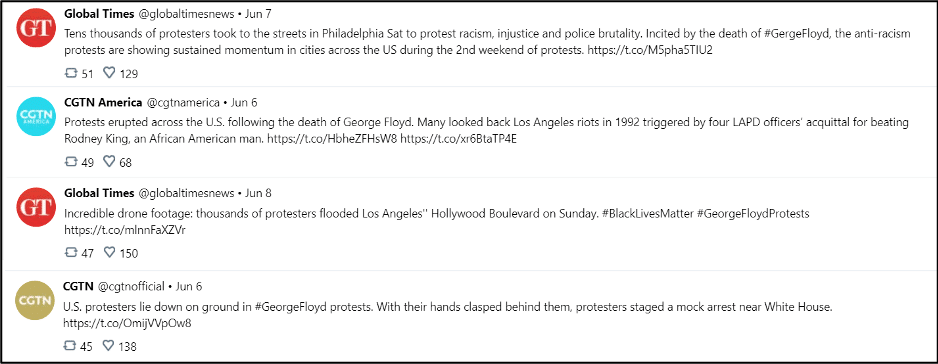
And, just like the previous week, Chinese state media devoted many stories to anti-racism protests taking place in the rest of world, particularly in places normally seen as U.S. allies. This coverage implied that the United States is isolated, even among friends.
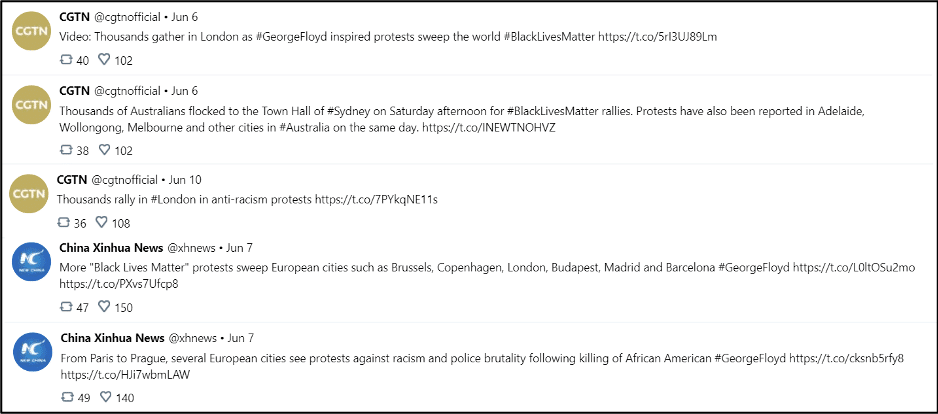
As protests in the United States turned less volatile (note: this report covers a date range before the shooting of Rayshard Brooks and subsequent protests in Atlanta), Chinese state media outlets pivoted to cover conversations around police reform, in particular the idea of “defunding the police.”

However, there were a few examples of more inflammatory content, including a video posted by CGTN America titled “Watch what happens when men in KKK hoods appear at an anti-racism rally.” The video shows police escorting two men in white hoods away from a rally while on-screen text prompts viewers to imagine an alternative reality by asking: “What do you think could have happened if the police didn’t escort these two away?”

Coronavirus Stories Back at the Top
Somewhat eclipsed in recent weeks by coverage of Beijing’s national security law for Hong Kong and then by anti-racism protests in the United States, coronavirus was once again the focus of most of last week’s top tweets. Hua Chunying, the spokesperson for the Chinese foreign ministry known for a couple of highly controversial tweets surrounding the killing of George Floyd, promoted an official report on China’s supposedly exemplary containment of the outbreak.
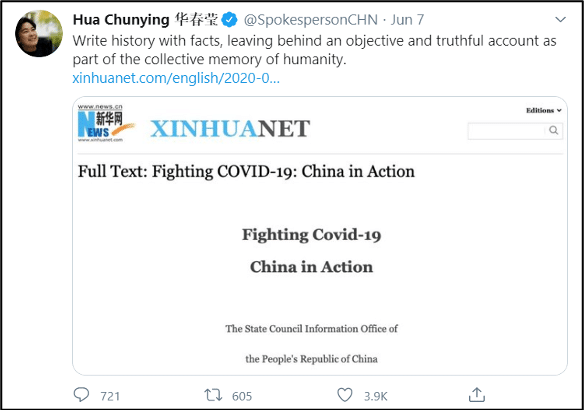
On Facebook, coronavirus was the subject of the four most shared Chinese state media stories last week. The most shared story, “China makes nucleic acid tests mandatory for eight groups of people,” was a very brief travel advisory, warning anyone traveling to China that they would be subjected to compulsory coronavirus testing upon arrival in the country.
Like two weeks ago, several stories combined coronavirus coverage with anti-racism protests in the United States. For instance, Xinhua’s “‘U.S.-style human rights’ crisis magnified by COVID-19” opens with the American government’s poor response to the outbreak before seamlessly transitioning to issues of racial and economic inequalities in the country. A couple of video segments posted by CGTN contained similar narratives.

However, the coronavirus-related story that drew the most attention was the release of a Harvard study claiming that China had coronavirus cases as early as August 2019. Nationalist tabloid Global Times and its firebrand editor Hu Xijin led the countercharge against the university:
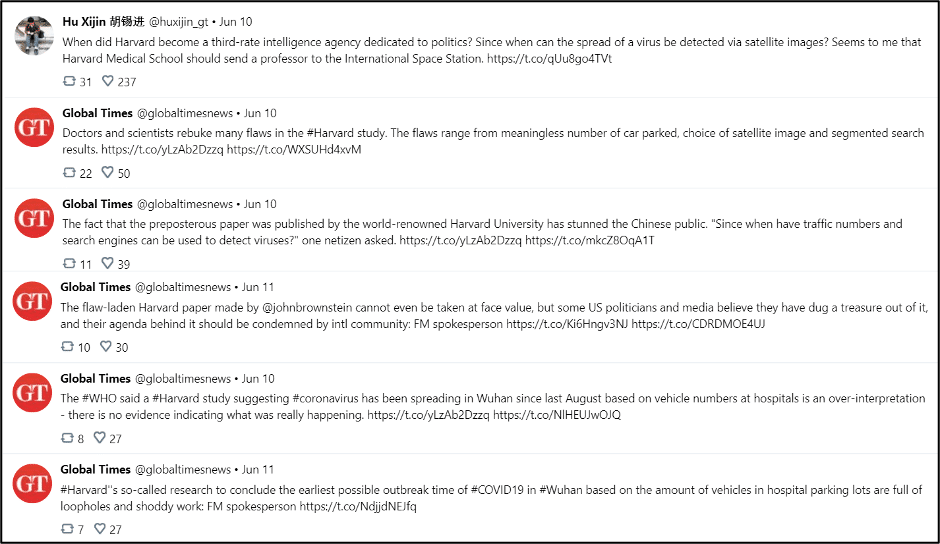
Spokesperson Hua Chunying reacted strongly to the study in her June 9 press conference, and again on Twitter on June 11.
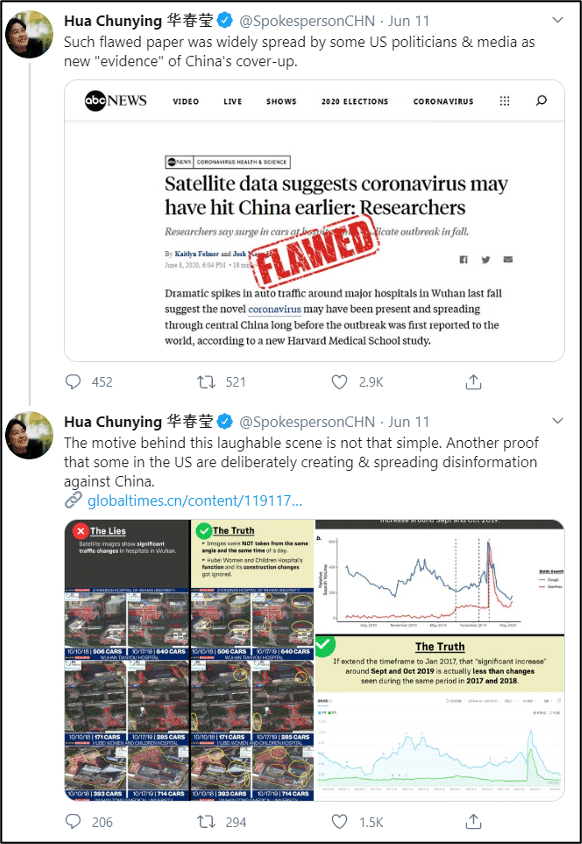
In addition, several Chinese diplomats and embassies, from the Netherlands to Turkey, also criticized the study, frequently quoting Hua’s denunciation:
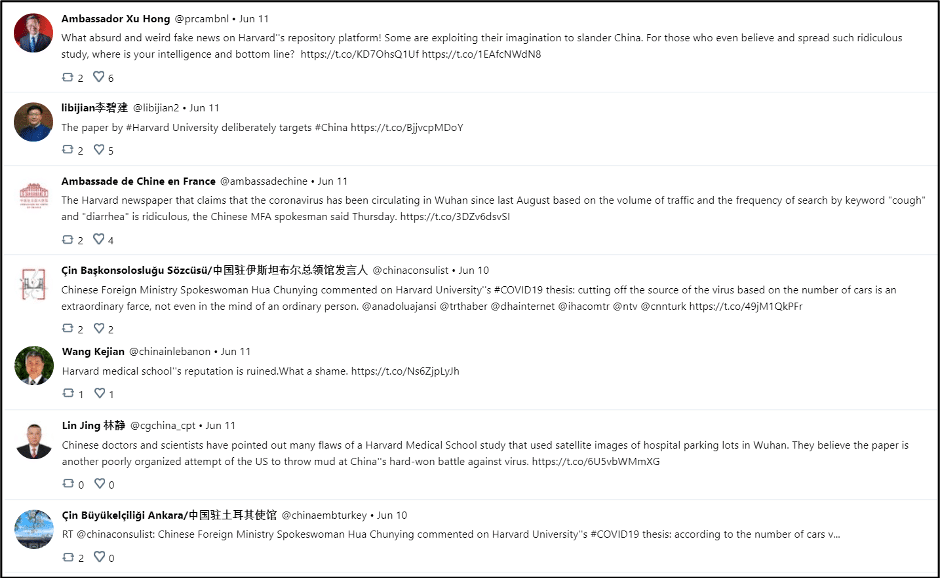
While the majority of coronavirus-related content published by state media covered basic news updates, a small percentage continued to push unfounded conspiracy theories. For instance, on June 12, China Daily posted an infographic about the “Dark history of Fort Detrick biological warfare lab.” In this infographic, the reader can learn about the CIA’s “mind control project” or about “secret psychochemical experiments on human subjects.” The infographic strongly implies that the facility was behind the outbreak of coronavirus.
Chinese state-funded media and government and diplomatic corps accounts:
Top 10 Hashtags — June 6-June 12:

The Hamilton dashboard collected approximately 16,000 tweets from monitored Twitter accounts between June 6 and June 12, which was a slight decline from the past two weeks. The number of tweets containing the hashtags #GeorgeFloyd, #US, and #HongKong were down by more than 50 percent from the previous week, while uses of #Covid19 increased by more than 15 percent.
In a meta moment, China’s diplomatic and media accounts on Twitter used Twitter to roundly criticize the company after it removed 170,000 pro-Beijing accounts. Claims of censorship against “ordinary Chinese people” also failed to note that ordinary Chinese people are prohibited from accessing Twitter within China.

Websites
Chinese government-funded websites:
Continuing a trend of China’s state media attacking those critical of Beijing’s response to the pandemic (see last week’s report noting coverage of Brazil), Australia, which has drawn Beijing’s ire over its calls for an international investigation into the origin of the coronavirus, was singled out this week for its treatment of protestors and minorities:
“Chinese advised against traveling to Australia amid racial discrimination, violence,” CGTN, June 6, 2020.
“There has been an alarming increase in acts of racial discrimination and violence against Chinese and Asians in Australia recently.”
“Australian PM calls for racism protesters to be charged,” CGTN, June 11, 2020.
“Black Lives Matter protesters should be punished for ignoring coronavirus lockdown rules Australia’s prime minister said Thursday, sparking anger by also claiming slavery never existed in the country. (…) Historians (…) pointed to evidence of indentured Aboriginal workers and thousands of slaves taken (…) to work on Australian sugar cane plantations.”
In another continuation of a theme, American “interference” abroad was highlighted in a CGTN story covering India’s foreign minister rebuke of a U.S. effort to assess religious freedoms in the country:
“India says U.S. has no standing to judge its religious freedom,” CGTN, June 11, 2020.
“India (…) [says] foreign agencies have no standing to assess the constitutional rights of citizens. (…) The government firmly repudiated the surveys of the commission, describing it as biased and prejudiced. (…) India would not accept any foreign interference or judgement on matters related to its sovereignty,”
Lastly, two articles among the ten most shared stories on Facebook touched on Hong Kong and Taiwan—two democratic thorns in Beijing’s side:
“Curb on U.S. dollar trading in Hong Kong may damage global confidence in U.S. assets: HK finance chief,” Xinhua, June 7, 2020.
“To limit U.S. dollar trading in Hong Kong will in return damage global confidence in the U.S. dollar and U.S. financial assets. Extreme measures, such as restricting Hong Kong using the U.S. dollar or the settlement system, are also highly risky to the United States itself.”
“Mainland spokesperson: ‘Taiwan independence’ biggest obstacle to cross-Straits ties,” CGTN, June 12, 2020.
“A Chinese mainland spokesperson on Friday condemned the collusion of Taiwan’s Democratic Progressive Party with external forces.”
Broadcasts
Chinese state-owned media:
One story that attracted a lot of video coverage was Chairman Xi’s visit to Ningxia, the province home to the Hui ethnic minority. A predominantly Muslim group, the Hui are often held up by Beijing as the “good” Muslims in opposition to Xinjiang’s Uyghurs. However, there have recently been reports of a clamp down on religious freedom in Ningxia. Coverage of Xi’s visit ranged from seemingly innocuous economic development segments to those stressing the need for “ethnic and national unity.”
“Xi Stresses Ecological Protection, High-quality Development of Yellow River Basin,” CCTV, June 10, 2020.
“Ningxia should keep in mind the national interests and shoulder the responsibility to further cherish and protect China’s ‘Mother River’, Xi said.”
“Xi Inspects Community in Ningxia, Stresses National Unity,” CCTV, June 8, 2020.
“Just now I saw that your community has very good experience, particularly in terms of the harmonious relationship among different ethnic groups. (…) None of the ethnic groups should be left behind in poverty reduction and in building a moderately prosperous society in all aspects and a modern socialist country.”
“Xi Inspects Community in Northwest China’s Ningxia, Stressing Ethnic Unity,” CCTV, June 10, 2020.
“More than 13,000 residents live in this community, nearly half of them are of ethnic minority groups. It represents the fine tradition of the Chinese nation and the greatest strength of the socialist system with Chinese characteristics when people of all ethnic groups walk hand in hand.”
“Xi Jinping Encourages Ningxia People to Make Greater Contribution to China’s Rejuvenation,” CCTV, June 10, 2020.
“[Xi] also underlined the need to adhere to the [Chinese Communist Party]’s basic principles regarding religious work and strengthen the management of religious affairs according to law.”
Finally, a segment on a new oil rig being built in the South China Sea boasted about the technological prowess of the construction, with no mention of the fraught geopolitical tensions in the region.
“Operation Completed at First Exploitation Well of China’s Major Deepwater Gas Field,” CCTV, June 10, 2020.
“Drilling operation has been completed at the first exploitation well of China’s major deepwater gas field in the South China Sea, the national offshore oil and gas producer CNOOC announced in a release on Tuesday.”
Iran
Always Eager to Highlight Injustice in American Governance and Society
Iranian propaganda frequently focuses on instances of American hypocrisy and social injustice, which in the past few weeks has meant highlighting the death of George Floyd at the hands of Minneapolis police, as well as acts of violence perpetrated by police against protestors. This focus has been particularly heavy in Iran’s Spanish-language content:

Where possible, Iranian outlets used American commentators as validators to call out what they see as hypocrisy in the international reaction to protests and police violence in the United States versus international reactions to protests and state-backed violence in Iran:
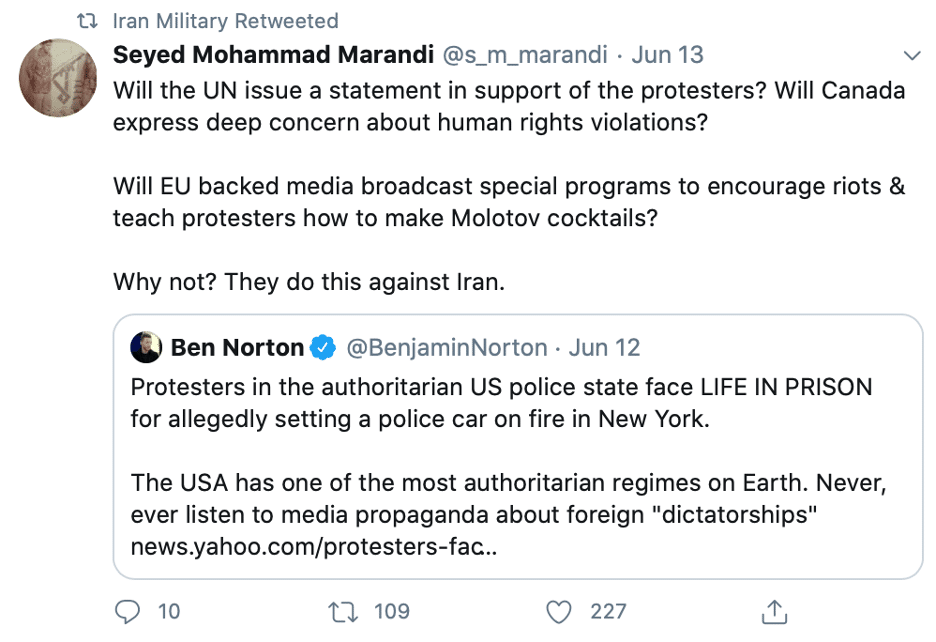
Iranian state media often compared violence by American police to violence by law enforcement and the security services of other Iranian adversaries, like Israel, the United Kingdom, and Saudi Arabia:

 In other instances, domestic unrest was explicitly linked to American foreign policy:
In other instances, domestic unrest was explicitly linked to American foreign policy:


The most explicit example of this linkage was in the coverage of Rouhani’s statement comparing the treatment of George Floyd in the United States to Iran’s treatment by the United States. The PressTV story covering Rouhani’s remarks had the most Facebook engagement of any story during the past week.

As we’ve seen in the past, Iranian propagandists are also eager to amplify anti-U.S. content coming from Chinese and Russian officials and state media. PressTV’s coverage of Vladimir Putin’s commentary on the “deep-seated crises” in American society was the 11th most interacted with story coming out of Iranian state-backed news outlets in the past week.
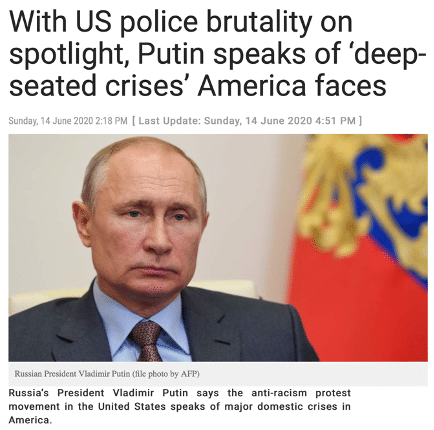


Celebrating Iranian Cooperation with America’s Adversaries
Another distinct thread last week was the promotion and celebration of Iranian cooperation with Venezuela. This included substantial coverage of the arrival of an Iranian oil tanker in a Venezuelan port, which was cast as a relief mission to diminish the impact of U.S. sanctions on the country. A similar story reported on Iranian pilots and mechanics helping the Venezuelan Air Force maintain readiness in defiance of U.S. sanctions:



Criticizing American Disregard for International Law and Global Norms
A perennial theme, particularly for Foreign Minister Javad Zarif and other Iranian diplomats, remains perceived American lawlessness on the global stage:



Such narratives accounted for four of the top ten most engaged-with stories on Facebook last week.

Iranian state-funded media and government and diplomatic corps accounts:
Top 10 Hashtags — June 6-June 12:
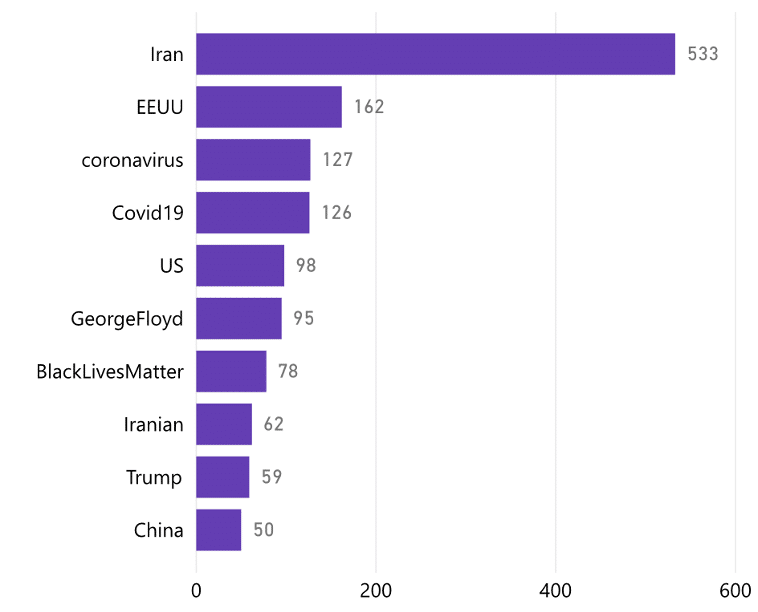
The top ten hashtags from Iranian state-backed media and diplomatic accounts on Twitter reflected the greater narrative trends about a dysfunctional American government that disregards norms and laws at home and abroad. (#EEUU—“USA” in Spanish—reflects the high proportion of Spanish-language content). Commentary on the coronavirus pandemic included positively framed stories about Iran’s successes at fighting the virus, negatively framed stories about the response of the U.S. government generally and President Donald Trump in particular, and relatively neutrally framed stories reporting on the progress of the virus in other—mostly Latin American—countries.

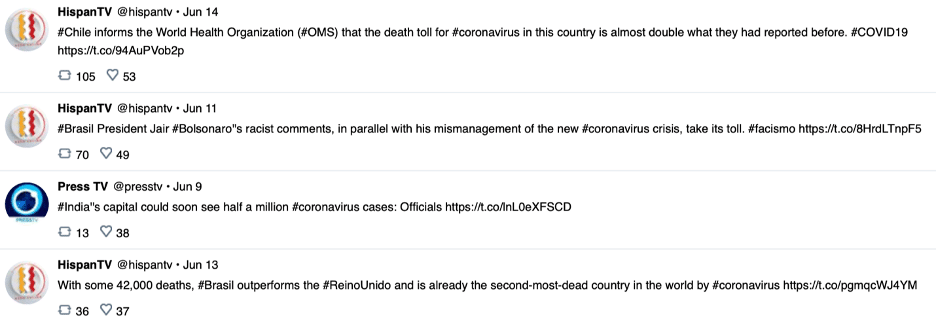


Websites
Iranian government-funded websites:
By Facebook shares, PressTV was the most interacted with Iranian state-backed news website by a wide margin. Across the board, however, engagement numbers were (and consistently are) well below those of Russian and Chinese government-funded media on Facebook, reflecting the rather limited impact of Iranian media on western social media platforms.
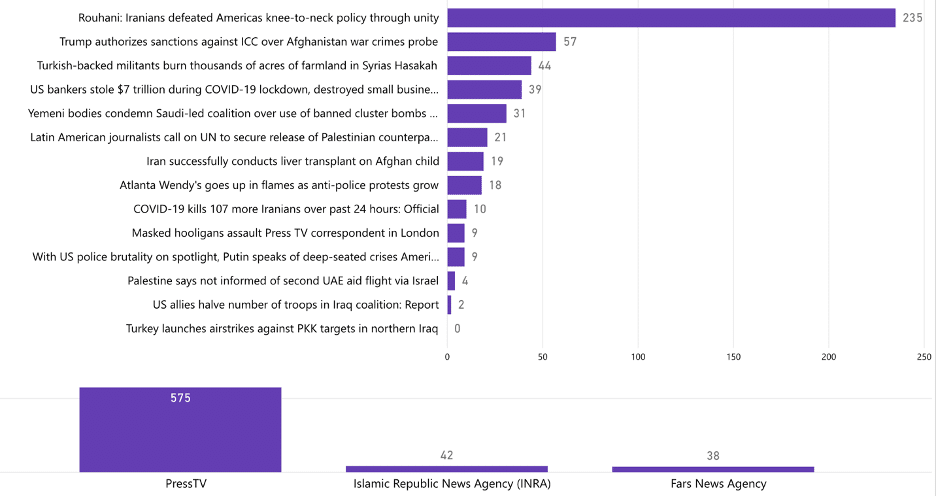
The views expressed in GMF publications and commentary are the views of the author alone.

